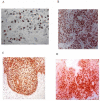The possible role of cell cycle regulators in multistep process of HPV-associated cervical carcinoma
- PMID: 17521451
- PMCID: PMC1894982
- DOI: 10.1186/1472-6890-7-4
The possible role of cell cycle regulators in multistep process of HPV-associated cervical carcinoma
Abstract
Background: Human papillomavirus (HPV) 16 and 18 are associated with cervical carcinogenesis through an interaction between HPV oncogenic proteins and cell cycle regulatory genes. However, the exact pathogenetic mechanisms are not determined yet.
Methods: We investigated 43 invasive squamous cell carcinoma (ISCC), 38 CIN III, 11 CINII and 18 CINI for cyclin D1, cyclin E, CDK4, p53, mdm-2, p21(waf), p27, p16(INK4A), Rb and Ki-67 aberrations using immunohistochemistry and molecular techniques. Twenty samples of normal cervical tissues (NCT) were taken as a control.
Results: There was a significant increase in the expression of Ki-67, cyclin E, CDK4, p16(INK4A), Rb (p= 0.003, 0.001, 0.001, 0.01) and a significant decrease in p27(KIP1) from NCT to ISCC (p = 0.003). Increased cyclin D1, p21(waf), p53, mdm-2 expression, homozygous deletion (HZD) and promoter methylation (PM) of the Rb were detected in CINIII and ISCC only. On univariate analysis; tumor size, differentiation, lymph node status, FIGO stage, Ki-67, cyclin D1, p53 and p27(KIP1) are significantly associated with reduced overall survival (OS) while on multivariate analysis; only FIGO stage, Ki-67, cyclin D1, p53 and p27(KIP1) were significant.
Conclusion: 1) Aberrations involving p27(KIP1), cyclin E, CDK4, p16(INK4A) are considered early events in HPV 16 and 18-associated cervical carcinoma, whereas cyclin D1 and p53 pathway abnormalities are considered late events. 2) Immunohistochemical tests for p16(INK4A) and cyclin E, could help in early diagnosis of cervical carcinoma. 3) Only FIGO stage p53, cyclin D1, p27(KIP1) and Ki-67 are independent prognostic factors that might help in predicting outcome of cervical cancer patients.
Figures








References
-
- Klaes R, Woerner SM, Ridder R, Wentzensen N, Duerst M, Schneider A, Lotz B, Melsheimer P, Von Knebel Doeberitz M. Detection of high risk cervical intraepithelial neoplasia and cervical cancer by amplification of transcripts derived from integrated papillomavirus oncogenes. Cancer res. 1999;59:6132–9616. - PubMed
-
- Howley PM, Scheffner M, Munger K. Oncoproteins encoded by the cancer-associated papillomavirus target the products of retinoblastoma and p53 tumor suppressor genes. Quant Biol. 1991;56:149–155. - PubMed
-
- Spitokovsky D, Aengeneyndt F, Braspenning J, Doeberitz VK. P53-independent growth regulation of cervical cancer cells by the papillomvirus E6 oncogene. Ocogene. 1996;13:1027–1035. - PubMed
LinkOut - more resources
Full Text Sources
Research Materials
Miscellaneous

